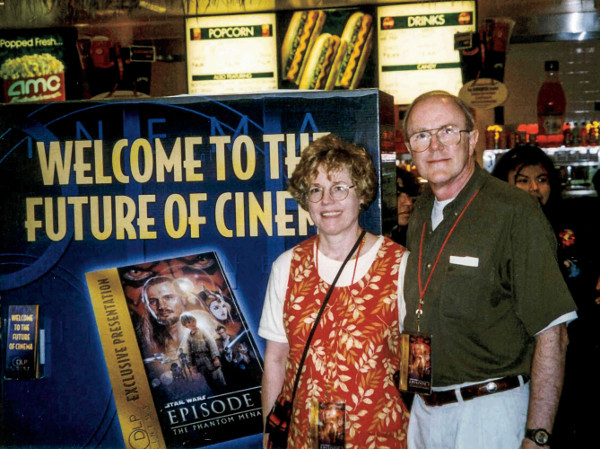Let There Be Light: Larry Hornbeck on Inventing DLP Page 2
LH: The first DLP subsystems for conference room projectors were delivered to manufacturers by April 1996 and were on the market soon after.
DLP technology delivered the appearance of a nearly seamless image owing to the small spacing between its mirrors. Working with manufacturers over succeeding years, DLP projectors were introduced that would revolutionize the conference room projection market with higher brightness and contrast, and much reduced weight and volume. That was just the beginning of markets that would range from pico projectors to digital cinema.
Quite frankly, I was surprised at the breadth of markets in which DLP technology provided unique advantages to various applications. I won the Emmy Engineering Award in 1998 from the Academy of Television Arts & Sciences for digital micromirror technology. Believe me, it was a great feeling at the time. But nothing could have prepared me for the feeling of winning an Academy Award of Merit (Oscar Statuette) from the Academy of Motion Picture Arts & Sciences in February of this year.
We have watched movies the same way for 115 years—on film. Today more than eight out of 10 theaters globally project the best Hollywood has to offer with vibrant, bright and vivid digital imagery using DLP Cinema technology, thanks to my invention and the passion of a small team of engineers focused on digital cinema, not to mention the combined efforts of hundreds of TI engineers over the last 28 years.

S&V: Is there a reason why all of the tiny Pico projectors we’re seeing in the market seem to use DLP technology? Is there something about the technology that makes it particularly suitable for miniaturization or portable applications?
LH: Yes, there are inherent characteristics of the DLP chip that make it particularly suitable for miniaturization or portable applications.
1. Precise, programmable and reliable modulation of light—stable to within the accuracy of time division, the basis for all DLP technology. These features are not compromised in compact pico designs.
2. Rugged, highly reflective aluminum micromirrors that reflect heat and are optically efficient with both polarized and un-polarized light. And they work well with all light sources—lamp, LED, laser, or polarized light for 3D applications. LED sources enable compact optical designs as in pico-projectors.
3. Fast switching speed of the micromirrors combined with high optical efficiency of reflective aluminum enables extremely compact, one-chip DLP pico systems.
4. Scalability of micromirror size allows smaller chips for the same resolution, e.g. pico applications.
5. Standard semiconductor manufacturing which builds on TI’s infrastructure and expertise.
S&V: Is there anything you’d like to add?
LH: There’s a quote from my Oscar acceptance speech that I think pretty well sums things up:
“It’s extremely gratifying to work for a company that allows its employees to bring their passion and creativity to life and in this case to bring it to life on the big screen. Wow! You can’t do any better than that.
“So we have created a technology that has advanced the cinema industry and enhanced our lives with many other innovative applications which have sprung from the central thesis that if you have digital micromirrors—10,000 times a second; it can be a one or zero—you create precisely the same image time after time.
“A cinematographer views his dailies and in Topeka, Kansas that’s what moviegoers see. Exactly those colors, exactly that incredible imagery.”
Watch Larry Hornbeck accept the Academy Award of Merit here.
Learn how DLP works here.
























































